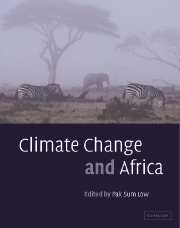Book contents
- Frontmatter
- Contents
- Notes on contributors
- Peer reviewers
- Editor's note
- Foreword
- Foreword
- Foreword
- Foreword
- Preface
- Preface
- Preface
- Preface
- List of abbreviations
- List of SI prefixes
- List of unit abbreviations
- List of chemical formulae
- Part I Science
- Part II Sustainable energy development, mitigation and policy
- Part III Vulnerability and adaptation
- 18 Potential impacts of sea-level rise on populations and agriculture
- 19 Sea-level rise and coastal biodiversity in West Africa: a case study from Ghana
- 20 The impacts of ENSO in Africa
- 21 Climate policy implications of the recent ENSO events in a small island context
- 22 El Niño causes dramatic outbreak of Paederus dermatitis in East Africa
- 23 The role of indigenous plants in household adaptation to climate change: the Kenyan experience
- 24 Requirements for integrated assessment modelling at the regional and national levels in Africa to address climate change
- 25 Climate and disaster risk reduction in Africa
- Part IV Capacity-building
- Part V Lessons from the Montreal Protocol
- Index
23 - The role of indigenous plants in household adaptation to climate change: the Kenyan experience
Published online by Cambridge University Press: 10 December 2009
- Frontmatter
- Contents
- Notes on contributors
- Peer reviewers
- Editor's note
- Foreword
- Foreword
- Foreword
- Foreword
- Preface
- Preface
- Preface
- Preface
- List of abbreviations
- List of SI prefixes
- List of unit abbreviations
- List of chemical formulae
- Part I Science
- Part II Sustainable energy development, mitigation and policy
- Part III Vulnerability and adaptation
- 18 Potential impacts of sea-level rise on populations and agriculture
- 19 Sea-level rise and coastal biodiversity in West Africa: a case study from Ghana
- 20 The impacts of ENSO in Africa
- 21 Climate policy implications of the recent ENSO events in a small island context
- 22 El Niño causes dramatic outbreak of Paederus dermatitis in East Africa
- 23 The role of indigenous plants in household adaptation to climate change: the Kenyan experience
- 24 Requirements for integrated assessment modelling at the regional and national levels in Africa to address climate change
- 25 Climate and disaster risk reduction in Africa
- Part IV Capacity-building
- Part V Lessons from the Montreal Protocol
- Index
Summary
Keywords
Climate variability; drought; coping mechanisms/strategies; biodiversity; indigenous plants; adaptation policies; farmer households; drylands; Kitui; Kenya
Abstarct
This chapter discusses household coping mechanisms during the 1996 drought in Kitui, a dryland agricultural area in Kenya. The 1996 drought and its effects on farmer households are described. Most households exhausted their food stocks several months before the next harvest was due in 1997. The alternative sources of food and income to which most households turned are discussed. Broadly speaking, there are two types of coping mechanisms: first, sources of food or income that are rated highly by interviewee households but to which few households have access; and second, sources of food or income to which most households resort, but which are not highly rated. The latter are often informal activities. Indigenous plants are input raw material in most household coping mechanisms, in particular in informal activities. Therefore, they are an important resource for the majority of households that do not have access to more formal sources of food and income during drought. There are, however, several constraints to indigenous plant-based activities. Unreliable sales and low profits contribute to their low status. Decreasing natural vegetation may limit the currently relatively cheap and easy access to indigenous plant resources. The chapter concludes that policies aimed at enhancing local indigenous plants and household capacity to cope with climatic variability can improve local welfare.
- Type
- Chapter
- Information
- Climate Change and Africa , pp. 248 - 259Publisher: Cambridge University PressPrint publication year: 2005
- 4
- Cited by



